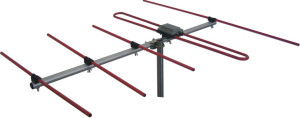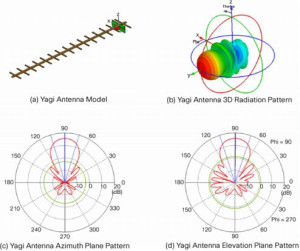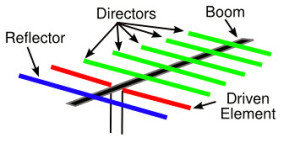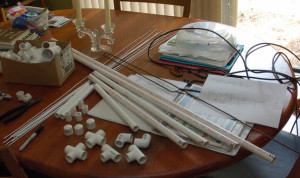What is Yagi Uda Antenna?
Before going into the design of an antenna we must know about the performance parameters or characteristics of antenna for communication applications.
For good efficacy and directivity for reception on radio spectrum, we
need a good Yagi-UDA antenna. This antenna was invented in the early 20th century by two Japanese engineers named Uda and Yagi.
The Yagi antenna is a narrow-band
antenna designed to work only on FM channel. It has the best gain for
its sizes and a correspondingly narrow main lobe (beam). A well designed
Yagi antenna as per the design given below can cover a line of site
distance of even 5 KMs with just 1 watt RF power. For the highest gain
or discriminating against an interfering signal 20deg-40 deg azimuth off
the desired signal, we use a Yagi antenna. Basically a Yagi antenna
consists of one reflector (in the rear), one driven element and one or
more directors (in the direction of direction/reception).
The above fig shows a Yagi antenna
consisting of four elements. The middle element is the simple half-wave,
folded dipole. It is termed the ‘driven element’ because it is only
element that is directly connected to the FM transmitter circuit,
driving the entire antenna. The other three outer elements are called
parasitic elements. One is called the director elements. The reflector
reflects RF energy and the director directs the RF energy. Typically,
the reflector element is 5 % longer than the driven element and the
director is 5% shorter than the driven element.
Radiation Pattern
The design of antenna relates to the
radiation pattern which refers to the dependence of directional
radiation from antenna. As Yagi Uda antenna is commonly known as Yagi
and is refers as directional antenna. A radiation pattern of an antenna
is a function of a graphical representation of properties of radiations
of antenna as a function of space coordinates. Most of the Yagi Uda
antennas are determined in the field of region and it is the function of
directional coordinates. The property of radiation is either two
dimension or three dimension distributions of radiation energy. It may
include power flux density, radiation intensity, field strength,
directivity or polarization.
A directional antenna or beam antenna is
an antenna, which radiates greater power in one, or more Directions
allowing for increased performance on transmit and receive and reduced
interference from unwanted sources. Directional antennas like Yagi-Uda
antennas provide increased performance over dipole antennas when a
greater concentration of radiation in a certain direction is desired. An
Omni directional antenna is an antenna system, which radiates power
uniformly in one plane with a directive pattern shape in a perpendicular
plane. Various parts of a radiation pattern are referred to as lobes,
which may be major, minor, side or back lobe.
There are many other types of radiation
patterns in Yagi Uda antenna, which are Isotropic antenna,
omnidirectional antenna, Directional antenna, hemispherical antenna.
Isotropic antenna radiates uniformly in all direction. Omnidirectional
antenna is those which radiates equally and this antennas having some
angle of elevations. Directional antennas radiates only on one
direction. Hemispherical antenna radiates one half of the hemisphere it
may be either lower or upper hemisphere.
Designing a Yagi Uda Antenna
The antenna parameters element lengths
and spacing are given in terms of wavelength, so an antenna for a given
frequency can be easily designed. The lengths of various antenna
elements are related to the frequency (f=106 MHz) is as follows:
- Reflector length =150/f(MHz) =150/106=1.41 Meters
- Driven element length =143/f(MHz) =143/106=1.35 Meters
- First Director length =138/f(MHz) =138/106=1.30 Meters
- Second Director length=134/f(MHz) =134/106=1.26 Meters
- Length of Boom=(43/106) + (45/106) + (45 /106)= 1.25 Meters approximately
Making a simple Yagi antenna by not
using aluminum pipes but cheap plastic material and some wire, however a
standard antenna with aluminum pipes is the best
Following materials are required for a low cost trial Yagi antenna.
- Get from any electrical shop 1” wide Plastic casing 12feet long – 1 Nos
- Get from any electrical shop ½ inch wide 12 feet long casings -2 Nos
- Any pole wooden / bamboo stick /iron pipe to hold the antenna
- Some cello tape
- A knife to cut the plastic case
- Get flat 2 core ribbon cable about 10 meters or more depending (Generally used for TV antenna, in early days) to be used as feeder wire from the transmitter circuit to the antenna.
- For primary support use the 1”, say it as boom.
- As per the dimensions cut the reflector, directors and driven element.
- And then run insulated or un-insulated wire along the boom on the top (not inside).
- Run similar wire across the directors and the reflector on the top (not inside).
- Join the points to the wire on the boom for directors, reflector by soldering.
- Take another wire more than the double of the driven element.
- Join the center to the boom point.
- Fold both the ends of that wire and bring them at bottom of the casing
- Take out 2 ends for connection and use cello tape to keep them in firm place.
- These 2 ends are meant for feed from the FM transmitter through the flat ribbon cable.
- Use cello tape to keep all the directors, reflector and the driven element like a yagi antenna.
Tuning Process of Yagi Antenna
- Connect the transmitter output to the antenna by the flat ribbon cable
- Adjust with a non ferrous screwdriver, the trimmer for oscillator frequency till you hear complete silence at around 106 MHz in a FM receiver or your cell phone if it has FM receiver facilities.
- Use a multimeter in 250 mA range in series with the battery supply
- Adjust the current to set the power to 75mA
Application of Yagi UDA antenna
- Yagi UDA antenna is mostly used in astronomical antennas and defense antennas.
- A helical antenna which is one of type of directional antennas is used for increasing the gain of the antenna.
- Polarization of these antennas is circular in nature. And these antennas are used in radio Astronomy.











No comments:
Post a Comment